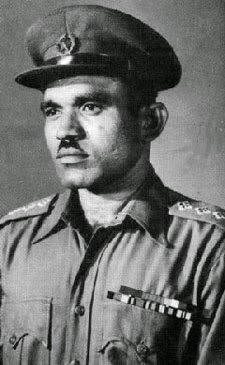Captain Anuj Nayyar
Anuj Nayyar (August 28, 1975 - July 7, 1999) was an officer of the 17 Jat Regiment of the Indian Army, who was posthumously awarded the Maha Vir Chakra, India's second highest gallantry award, for exemplary valour in combat during operations in the Kargil War in 1999.
He was born and grew up in Delhi, India in a Hindu family. His father, S.K. Nayyar, worked as a visiting professor in Delhi School of Economics while his mother, Meena Nayyar, worked for the South Campus library of Delhi University.Capt. Nayyar received his high-school education from Army Public School, Dhaula Kuan, New Delhi (1993 batch). He was a bright student who consistently performed well in academics and sports. He graduated from the National Defence Academy (90th course, Echo Squadron) and later was commissioned into the 17th Battalion Jat Regiment in June 1997 from the Indian Military Academy (100 Reg).
We should always go before our enemies with confidence, otherwise our apparent uneasiness inspires them with greater boldness.
Napoleon Bonaparte
On 06 July 1999, Charlie Company was tasked to capture an objective which was part of the Pimple Complex on the western slopes of Point 4875, at a height of 16,250 feet. At the beginning of the attack, the Company Commander got injured and the command of the company fell on Captain Anuj Nayyar, 17 Jat. Captain Nayyar continued to command his leading platoon into the attack under heavy enemy artillery and mortar fire. As the platoon advanced, the leading section reported location of 3 to 4 enemy bunkers. Captain Nayyar moved forward towards the first bunker and fired the rocket launcher and lobbed grenades into it. Thereafter, the section along with Captain Nayyar physically assaulted and cleared the bunker.
The enemy, which was well entrenched, brought heavy volume of automatic fire. Captain Nayyar, unmindful of his personal safety, motivated his men and cleared two more bunkers. While clearing the fourth bunker, an enemy RPG shell killed him on the spot. In this action, Captain Nayyar killed nine enemy soldiers and destroyed three medium machine gun bunkers of the enemy. The success of this operation, after a brief setback, was largely due to the outstanding personal bravery and exemplary junior leadership of Captain Nayyar. He displayed indomitable resolve, grit and determination and motivated his command by personal example, acting beyond the call of duty. For conspicuous gallantry and supreme sacrifice, Captain Anuj Nayyar was honoured with the Maha Vir Chakra, posthumously.












